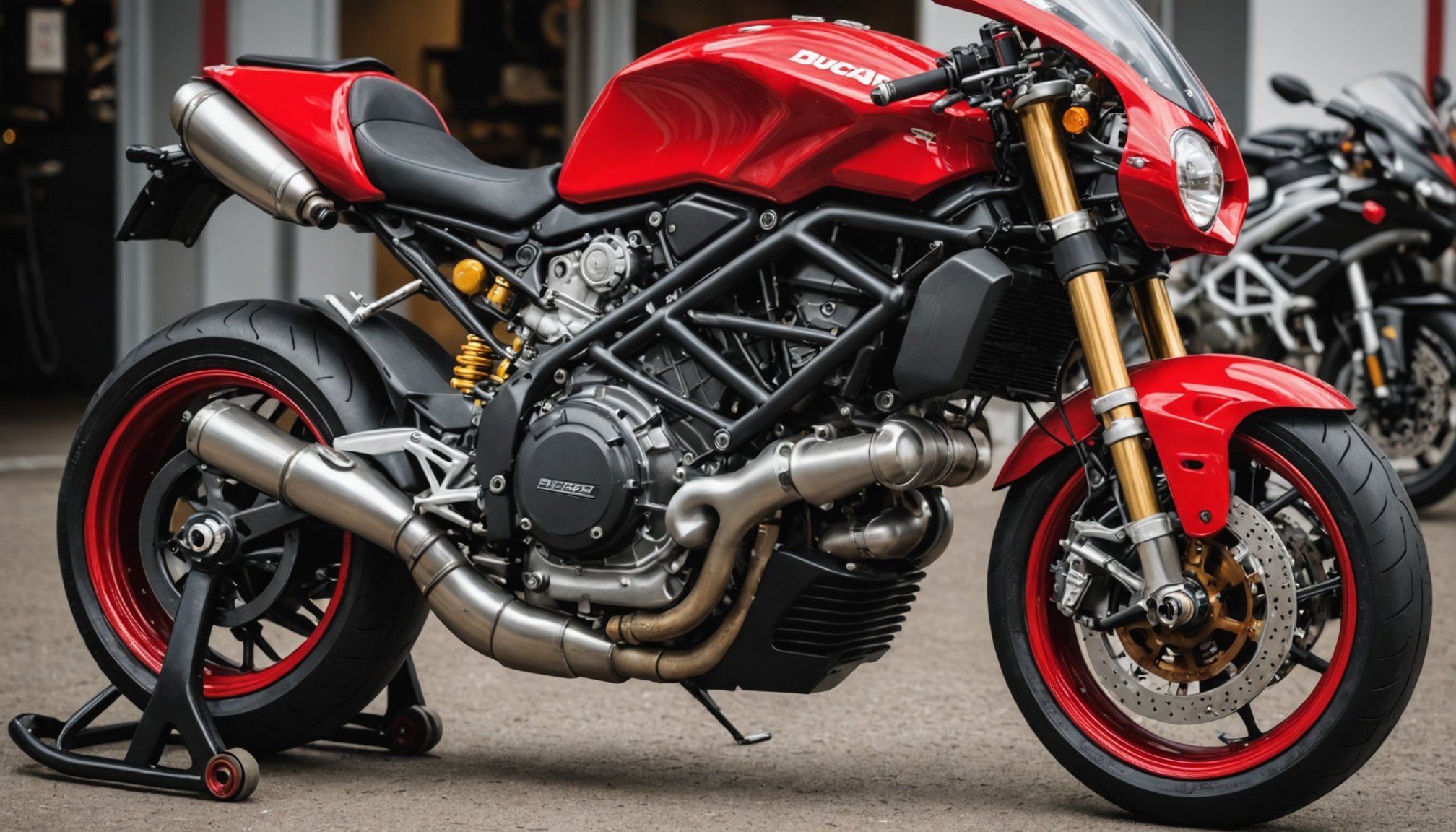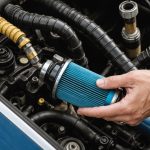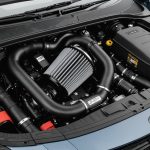Unveiling the Best Timing Belt Replacement Schedule for Your Ducati 998: A Guide to Enhanced Reliability
Understanding the Importance of Timing Belt Replacement
When it comes to maintaining your Ducati 998, one of the most critical components to focus on is the timing belt. This seemingly simple part is crucial for the smooth operation and longevity of your motorcycle’s engine. Here’s why replacing it at the right time is so important.
The timing belt in your Ducati 998 is responsible for synchronizing the rotation of the crankshaft and camshaft, ensuring that the valves and pistons move in perfect harmony. If this belt fails, it can lead to catastrophic engine damage, resulting in costly repairs or even requiring a new engine.
This might interest you : Step-by-Step Guide: How to Properly Install a Top Box on Your Honda Goldwing
Identifying the Right Replacement Schedule
Ducati recommends replacing the timing belt at specific intervals to prevent such disasters. Here are the general guidelines:
Manufacturer’s Recommendations
Ducati typically advises replacing the timing belt every 15,000 to 20,000 miles, depending on the model and usage. However, this is just a general guideline. For a Ducati 998, it is often recommended to replace the belt every 15,000 miles or every two years, whichever comes first[3].
Additional reading : Maximizing Braking Power: Enhancing Your Triumph Street Triple with Aftermarket Brake Pads
Factors Influencing Replacement
- Ride Conditions: If you frequently ride in extreme temperatures, carry heavy loads, or engage in aggressive riding, you may need to replace the timing belt more frequently.
- Maintenance History: Regular maintenance, such as checking and adjusting the timing belt tension, can extend its lifespan.
- Visual Inspection: Regularly inspect the belt for signs of wear, such as cracks, fraying, or uneven wear.
Preparing for the Replacement
Before you embark on replacing the timing belt, here are some steps and considerations to keep in mind:
Tools and Parts Needed
- New Timing Belt: Ensure you purchase a genuine Ducati timing belt or a high-quality aftermarket equivalent.
- Tensioner and Pulleys: These may also need to be replaced if they show signs of wear.
- Specialized Tools: You may need specific tools, such as a timing belt tension gauge and a crankshaft locking tool.
Step-by-Step Guide
Here is a simplified step-by-step guide to help you prepare:
- Remove the fairings and any other components that obstruct access to the timing belt.
- Mark the position of the crankshaft and camshaft sprockets to ensure proper alignment during reassembly.
- Release the tensioner and remove the old timing belt.
- Inspect and replace the tensioner and pulleys if necessary.
- Install the new timing belt, ensuring it is properly aligned and tensioned.
- Reassemble the components in the reverse order of how they were removed.
Detailed Checklist for Replacement
Here is a more detailed checklist to ensure you cover all the necessary steps:
Pre-Removal Checks
- Check the Owner’s Manual: Review the specific instructions for your Ducati 998.
- Gather Tools and Parts: Ensure you have all the necessary tools and replacement parts.
Disassembly
- Remove Fairings and Components: Access the timing belt area.
- Mark Sprocket Positions: Use a marker to mark the alignment of the sprockets.
- Release Tensioner: Use the appropriate tool to release the tensioner.
Removal
- Remove Old Timing Belt: Carefully pull the belt off the sprockets.
- Inspect Tensioner and Pulleys: Check for signs of wear and replace if necessary.
Installation
- Install New Timing Belt: Align the new belt with the marks made earlier.
- Tension the Belt: Use the timing belt tension gauge to set the correct tension.
- Reassemble Components: Put everything back in the reverse order of how it was removed.
Common Mistakes to Avoid
When replacing the timing belt, it’s crucial to avoid common mistakes that could lead to premature failure or engine damage:
Incorrect Tension
- Over-tightening: Can cause the belt to wear out faster or even break.
- Under-tightening: Can lead to belt slippage and engine misalignment.
Misalignment
- Incorrect Sprocket Alignment: Can result in poor engine performance or belt failure.
Using Incorrect Parts
- Non-Genuine Parts: May not meet the manufacturer’s standards, leading to reliability issues.
Comparative Analysis: Timing Belt vs. Chain
Many motorcycle enthusiasts debate whether a timing belt or a chain is better. Here’s a comparative analysis:
| Feature | Timing Belt | Timing Chain |
|---|---|---|
| Durability | Generally needs replacement every 15,000 to 20,000 miles | Can last the lifetime of the engine with proper maintenance |
| Maintenance | Requires periodic tension checks and replacement | Needs occasional adjustment and cleaning |
| Noise | Quieter operation | Can be noisier due to chain rattling |
| Cost | Less expensive to replace | More expensive to replace, but less frequent |
| Engine Type | Suitable for high-performance engines like the Ducati 998 | Often used in more robust engines, like those in Harley Davidson bikes |
Real-Life Examples and Anecdotes
A Close Call
One Ducati enthusiast shared a story about how he neglected to replace his timing belt on time. During a long road trip, the belt suddenly snapped, leaving him stranded in the middle of nowhere. The repair cost was substantial, and it could have been avoided with regular maintenance.
A Smooth Ride
On the other hand, another rider who religiously followed the replacement schedule never experienced any issues with his timing belt. He emphasized how important it is to stick to the manufacturer’s recommendations to ensure a smooth and reliable ride.
Practical Insights and Actionable Advice
Regular Inspections
- Visual Checks: Regularly inspect the timing belt for signs of wear.
- Tension Checks: Use a timing belt tension gauge to ensure the belt is properly tensioned.
Ride Modes and Traction Control
- While not directly related to the timing belt, ensuring your ride modes and traction control are properly set can reduce the stress on your engine and timing belt.
Suspension and Control
- Properly adjusted suspension can improve handling and reduce the impact on the engine and timing belt.
Replacing the timing belt in your Ducati 998 is a critical maintenance task that ensures the reliability and performance of your motorcycle. By following the manufacturer’s recommendations, avoiding common mistakes, and performing regular inspections, you can extend the life of your engine and enjoy a smooth, powerful ride.
Whether you’re cruising down the road on your Ducati Monster or embarking on an adventure with your KTM Super Adventure, a well-maintained timing belt is essential for a trouble-free journey. So, take the time to look after this vital component, and your bike will reward you with years of faithful service.
Additional Tips for Enhanced Reliability
-
Air Cooled vs. Liquid Cooled: Understand the differences between air-cooled and liquid-cooled engines and how they affect maintenance.
-
Air Cooled: Requires more frequent checks on components like the timing belt due to higher operating temperatures.
-
Liquid Cooled: Generally more stable but still requires regular maintenance.
-
Rear Wheel and Suspension: Ensure your rear wheel and suspension are properly adjusted to reduce stress on the engine and timing belt.
-
Fully Adjustable Suspension: Allows for better control and reduced wear on the bike’s components.
-
Cruise Control and Cornering ABS: While these features enhance the riding experience, they should be used judiciously to avoid unnecessary stress on the engine and timing belt.
-
Cruise Control: Useful for long highway rides but should be turned off in heavy traffic or rough road conditions.
-
Cornering ABS: Enhances safety but should be used with caution to avoid excessive braking, which can impact the timing belt.
By following these guidelines and tips, you can ensure your Ducati 998 remains in top condition, ready for any adventure that comes your way. Whether you’re a seasoned rider or new to the world of motorcycles, understanding and maintaining your timing belt is key to a reliable and enjoyable ride.











